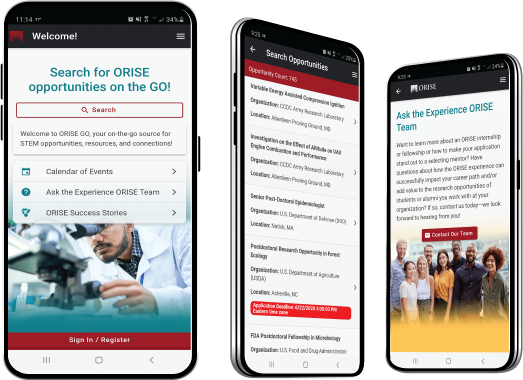EPA Fellowship on Incorporating Metabolic Competence Into High-Throughput Transcriptomics and Phenotypic Profiling Assays for Chemical Hazard Evaluation
-
An application
-
Transcript(s) – For this opportunity, an unofficial transcript or copy of the student academic records printed by the applicant or by academic advisors from internal institution systems may be submitted. All transcripts must be in English or include an official English translation. Click here for detailed information about acceptable transcripts.
-
A current resume/CV, including academic history, employment history, relevant experiences, and publication list
-
Two educational or professional recommendations. Click here for detailed information about recommendations.
*Applications may be reviewed on a rolling-basis and this posting could close before the deadline. Click here for information about the selection process.
EPA Office/Lab and Location: A research opportunity is available with the Rapid Assay Development Branch (RADB) at the Environmental Protection Agency (EPA), Office of Research and Development (ORD), Center for Computational Toxicology and Exposure (CCTE), Biomolecular & Computational Toxicology Division (BCTD) located in Durham, North Carolina.
Research Project: The Center for Computational Toxicology and Exposure (CCTE) within the United States Environmental Protection Agency (US EPA) Office of Research and Development (ORD) focuses on developing the tools, approaches and data needed to modernize and accelerate the pace of chemical risk assessment. CCTE also aims to foster the incorporation of non-traditional toxicity testing strategies - referred to as New Approach Methods (NAMs) - into regulatory decision making. A tiered hazard evaluation strategy using NAMs has been proposed for filling data gaps relating to the biological activity and potential hazard of chemicals found in the environment. The first tier of this strategy involves the use of high-throughput profiling (HTP) assays to efficiently and broadly characterize the biological activity of chemicals in human-derived cell models. To date, two first tier assays have been established at CCTE: 1) high-throughput transcriptomics with targeted RNA-Seq and 2) imaging-based high-throughput phenotypic profiling (HTPP) with Cell Painting. These assays are compatible with and have been applied to multiple human-derived cell types. However, the in vitro models employed thus far largely lack xenobiotic metabolizing capabilities found in intact organisms, including humans. This limits the ability of HTP assays to fully account for in vivo hazards, particularly in cases where metabolic transformation is required for modulating biological responses and/or toxicity.
This research project is aimed at introducing metabolic competence into cellular test systems used for first tier hazard screening. This will be accomplished using molecular biology and bioengineering techniques previously established at CCTE laboratories or through development of novel approaches as needs dictate. Specifically, alginate immobilization of metabolic enzymes (AIME) will be evaluated as a means of introducing metabolic competence into human-derived cancer or primary immortalized cell lines originating from various tissues. In vitro models with intrinsic xenobiotic metabolizing capability may also be evaluated for compatibility with first tier screening approaches.
The research participant will learn to: conduct laboratory and computational methods development, execute laboratory experiments and generate, analyze and report experimental results.
The participant will collaborate with a multidisciplinary team to:
- Design workflows for integrating first tier screening assays with the metabolic competence technologies.
- Define chemical training sets for technical validation of the integrated technologies.
- Devise computational workflows to evaluate shifts in bioactivity profiles and potencies in response to test chemicals.
Learning Objectives: Participatory activities and opportunities for gained experience include:
- Leadership and hands-on participation in experimental research in a toxicology laboratory setting.
- Develop technical proficiency in the use and implementation of laboratory automation technologies for high-throughput drug and chemical screening.
- Building expertise in computational toxicology approaches by leading data analysis efforts.
- Active participation in project team, branch and division meetings.
- Preparing presentations, internal reports and data summaries.
- Presenting at scientific conferences.
- Authoring manuscripts for publication in peer-reviewed journals.
Mentor(s): The mentor for this opportunity is Joshua Harrill (harrill.joshua@epa.gov). If you have questions about the nature of the research please contact the mentor(s).
Anticipated Appointment Start Date: March 1, 2023. All start dates are flexible and vary depending on numerous factors. Click here for detailed information about start dates.
Appointment Length: The appointment will initially be for one year and may be renewed up to five years upon EPA recommendation and subject to availability of funding.
Level of Participation: The appointment is full-time.
Participant Stipend: The participant will receive a monthly stipend commensurate with educational level and experience. Click here for detailed information about full-time stipends.
EPA Security Clearance: Completion of a successful background investigation by the Office of Personnel Management (OPM) is required for an applicant to be on-boarded at EPA.
ORISE Information: This program, administered by ORAU through its contract with the U.S. Department of Energy (DOE) to manage the Oak Ridge Institute for Science and Education (ORISE), was established through an interagency agreement between DOE and EPA. Participants do not become employees of EPA, DOE or the program administrator, and there are no employment-related benefits. Proof of health insurance is required for participation in this program. Health insurance can be obtained through ORISE.
ORISE offers all ORISE EPA graduate students and Postdocs a free 5 year membership to the National Postdoctoral Association (NPA).
The successful applicant(s) will be required to comply with Environmental, Safety and Health (ES&H) requirements of the hosting facility, including but not limited to, COVID-19 requirements (e.g. facial covering, physical distancing, testing, vaccination).
Questions: Please see the FAQ section of our website. After reading, if you have additional questions about the application process please email ORISE.EPA.ORD@orau.org and include the reference code for this opportunity.
The qualified candidate should have received a doctoral degree in one of the relevant disciplines, or be currently pursuing the degree with completion by June 30, 2023. Degree must have been received within the past five years.
Highly self-motivated and innovative individuals with a demonstrated track record of communicating research findings through oral presentations and peer-reviewed publications are encouraged to apply.
Preferred Skills:
- Any combination of experience with assay development, mammalian cell cultures, molecular biology techniques, microscopy and/or analysis of high content datasets.
- Ability to collaborate with a multidisciplinary team of EPA scientists to pursue research in the field of in vitro toxicology, new approach methods (NAMs) and next generation risk assessment (NGRA).
- Experience with the open source R statistical computing environment is highly desirable.
- Demonstrated experience communicating research findings through oral presentations and peer-reviewed publications.

 ORISE GO
ORISE GO

The ORISE GO mobile app helps you stay engaged, connected and informed during your ORISE experience – from application, to offer, through your appointment and even as an ORISE alum!





